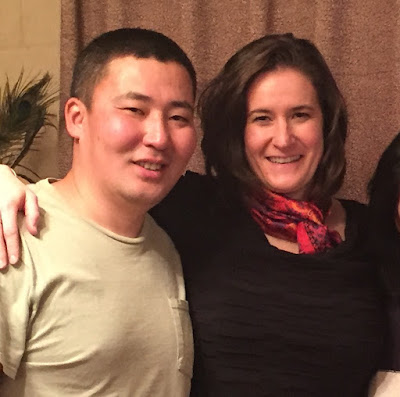Last year Zorig arrived home just in time for Tsagaan Sar. He sent me pictures of he and Enji with the rest of the extended family-- grandparents, aunts, uncles, cousins. I looked at the pictures and began to imagine what it would feel like to be a face in that crowd. While I would look different, would I feel like family?
Amazingly, a year has come and gone and I have experienced my first Tsagaan Sar in Mongolia. I will share my reflections and observations here, but first, for a nice overview of the event, please read this blog post by my friend and fellow American Wife, Michelle Borok. Her extended family has more roots in the countryside while my experience is more city-centered. Zorig's parents came to Ulaanbaatar as young children; he is a first generation city person, making Enji second generation. City folk celebrate Tsagaan Sar similarly, but with some adjustments here and there.
We went first to Zorig's parents' apartment on the eve of Tsagaan Sar to share food and drink, and to toast the incoming new year as a nuclear family. Home just before midnight, we slept shortly and were up before 7 am to prepare and leave. Back to the in-laws by taxi, where we greeted the new year and received gifts. We piled into my father-in-law's Land Cruiser and made our way to the home of the eldest family member--Zorig's 91-year-old grandmother.
 |
| Most of the family |
Shortly after 9 am, the family was assembled and the traditional greetings and offerings began. From oldest to youngest, family members pay respect to their elders. Younger members place their hands and arms underneath the elders and lean in to "sniff-kiss" one cheek and then the other. A monetary gift is also offered. As the elders are honored, the rest of the family continues to offer similar greetings and wishes for the new year all around, paying attention to rank in the family by age.
 |
| Buuz fresh from the kitchen |
By late morning, we departed. Most people have multiple homes to visit and there seems to be a rotation. After some brief down time at home, Zorig and I walked from our home to visit his mother's sisters. The first a sister by marriage, the other her older sister. Both of these apartments were within very short walking distance of our home. We spent 30-60 minutes at each home--long enough to drink milk tea, enjoy some of the salads, and to have a fresh round of buuz presented, all the while chatting and visiting. This was my first time to meet members from Zorig's mother's family and I very much enjoyed meeting them, seeing their homes, and having the opportunity to get acquainted. On Wednesday evening we visited one more home.
 |
| Three different presentations of the Ul Boov |
As a foreigner trying to explain this holiday to my countrymen at home in the U.S., I would say it feels like a blend of Thanksgiving and New Year's, plus a little something extra. Thanksgiving includes a host of traditional foods and is about family gathering together to offer thanks for their health, their good fortunes, for life. New Year's is about the hope and well wishes for good things in the year to come. Those two things, PLUS a ceremonial recognition and respectful appreciation to one's elders is what Tsagaan Sar felt like to me. I couldn't think of anything we have in the U.S. that would be similar to this third element. Perhaps because we are a young country that lacks centuries old traditions? Perhaps because we are a melting pot of diverse cultures?
Ultimately, Tsagaan Sar is about family--the blood that connects us and binds us to our pasts, as well as the new connections made through marriage that hold the future of our families in them. I feel honored to be warmly received into this new world, culture, home, and family. My first year of education and assimilation continues, but one thing remains the same--I've never been happier than I am now. Happy New Year to you all--may this Year of the Monkey hold health and happiness for each and every one of you.

No comments:
Post a Comment